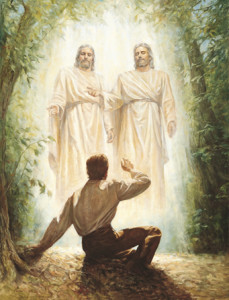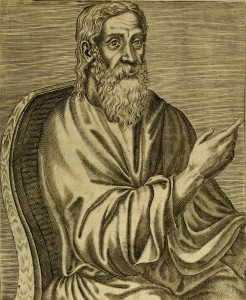 This post by FairMormon volunteer Jordan Latimer was originally delivered as a farewell address on May 24, 2015. Elder Latimer will begin his service as a missionary in the Oklahoma Tulsa Mission of The Church of Jesus Christ of Latter-day Saints in June 2015.
This post by FairMormon volunteer Jordan Latimer was originally delivered as a farewell address on May 24, 2015. Elder Latimer will begin his service as a missionary in the Oklahoma Tulsa Mission of The Church of Jesus Christ of Latter-day Saints in June 2015.
Early in the spring of 1820, a troubled young man named Joseph Smith retired to a grove near his home and prayed to God. He was unsure which of the churches of that day he should join. Kneeling down, he asked God to provide him with the answers he so earnestly desired. He desired his salvation and wanted to know which church would be able to grant it. His prayer was answered, and in quite an extraordinary manner. Two beings appeared to him, identifying themselves as Heavenly Father and Jesus Christ. Christ answered Joseph’s question, informing him that none of the churches of the day had the ability to provide him with what was necessary for salvation. He instructed him to join none of the churches, because the fullness of his gospel was to be restored in his lifetime. Little did Joseph know that it was through him that it would be restored.
This experience set in motion what we in The Church of Jesus Christ of Latter-day Saints call the Restoration.
After the death of the Christ’s apostles, the authority to perform priesthood ordinances was lost for centuries, and the world entered a state of apostasy. This apostasy had been prophesied by Paul in his 2nd epistle to the Thessalonians: “Let no man deceive you by any means: for that day [meaning the day of Christ’s return] shall not come, except there come a falling away first, and that man of sin be revealed, the son of perdition” (2 Thess. 2:3) Many early Christians probably didn’t expect this “falling away” to come so soon. Not only did the death of the apostles cause a loss of authority, it also led to unauthorized changes in doctrine and ordinances.
But his epistle to the Thessalonians is not the only place where prophecies of the coming apostasy can be found. When speaking to the elders at Ephesus, Paul said that after his departing, “grievous wolves [shall] enter in among you, not sparing the flock. Also of your own selves shall men arise, speaking perverse things, to draw away disciples after them” (Acts 20:29). He informed Timothy that “the time will come when they will not endure sound doctrine; but after their own lusts shall they heap to themselves teachers, having itching ears; And they shall turn away their ears from the truth, and shall be turned unto fables” (2 Tim. 4:3). Peter also prophesied of such corruption, saying that false teachers would “bring in damnable heresies, even denying the Lord that bought them, and bring upon themselves swift destruction. And many shall follow their pernicious ways; by reason of whom the way of truth shall be evil spoken of” (2 Pet. 2:1).
The death of the apostles resulted in the loss of the priesthood keys needed to perform saving ordinances. Also, because there was no prophet on the earth, revelation could no longer be received for all of Christ’s church. The pure doctrines of Christ began to be corrupted by the philosophies of men. Without the gift of the Holy Ghost, people struggled to determine the difference between truth and falsehood. The church that Christ established was ultimately lost.
Fortunately, the Lord planned to restore the gospel in the latter-days, prior to his coming. This restoration would usher in the last days and would be the final time that Christ would restore his church upon the earth. We know that Joseph Smith was the vessel through which truths were restored. A list of things restored may be helpful.
The Restoration restored the true nature of the relationship between Heavenly Father, his son Jesus Christ, and the Holy Ghost. In the 4th century A.D. the doctrine of the Trinity was first articulated. This blend of Greek philosophy and Christianity introduced a concept of God people have been trying to comprehend ever since. Joseph Smith restored knowledge of the true nature of the Godhead: that they are three separate beings, who are united in purpose. Joseph restored the concept that we are children of both a Heavenly Father and a Heavenly Mother. Jesus Christ is our brother, the first spirit-born of the Father, and the savior of the world. Both Heavenly Father and Jesus Christ have bodies of flesh and bone. The Holy Ghost is a personage of spirit, and its role is to comfort, testify of truth, and bestow gifts of the spirit. As Moroni said: “By the power of the Holy Ghost ye may know the truth of all things” (Moroni 10:5). The Restoration rejected the idea of Original Sin. Instead of the Fall being a grievous mistake by Adam and Eve, it was a necessary part of the plan of salvation for God’s children. Adam and Eve didn’t mess things up. They did what was necessary to move God’s plan forward. As the prophet Lehi said, “Adam fell that men might be. And men are, that they might have joy” (2 Nephi 2:25). And while most Christians believe that Eve, the mother of all living, failed, we know that she actually succeeded. Eve’s role in moving the plan forward is very significant. True to the title of “mother,” she made the choices necessary for mankind to exercise their powers of procreation and provide bodies for God’s spirit children. The role of righteous women cannot be dismissed when the true story of the Garden of Eden is realized.
The Restoration simplified and clarified the first principles and ordinances of the Gospel. These are listed in the 4th Article of Faith. “We believe that the first principles and ordinances of the Gospel are: first, Faith in the Lord Jesus Christ; second, Repentance; third, Baptism by immersion for the remission of sins; fourth, Laying on of hands for the gift of the Holy Ghost” (Article of Faith 4). While such concepts have always been a crucial part of Christianity, the LDS church provides this outline in its purest, simplest form. It also clarifies the manner in which baptism is to be performed. Immersion is required. This is symbolic of the death of the natural man, and the birth into sainthood.
The Restoration restored the power of the priesthood, and the authority to act in God’s name. All of the keys necessary for providing saving ordinances and of receiving revelation for God’s children now reside with our current prophet, President Thomas S. Monson. As the 5th Article of Faith says, “We believe that a man must be called of God, by prophecy, and by the laying on of hands by those who are in authority, to preach the Gospel and administer in the ordinances thereof” (Article of Faith 5). Through the priesthood power, we can be baptized, receive the Holy Ghost, be endowed, and be sealed to spouses and other family members in the House of the Lord.
Speaking of the House of the Lord, the Restoration restored the practice of building and worshiping in temples. In the temple, we can perform ordinances necessary for eternal life. The initiatory and the endowment ceremony are both ordinances that help qualify us for exaltation. They provide power from God, and help to protect us from the deception of the adversary. Such blessings are not only for the living, however. The temple allows and encourages work for the dead. How comforting this doctrine is, to know that the blessings of salvation can be provided to our ancestors who have passed on. It is a fulfillment of the words of Moroni, who said that the prophet Elijah “shall plant in the hearts of the children the promises made to the fathers, and the hearts of the children shall turn to their fathers. If it were not so, the whole earth would be utterly wasted at his coming” (Joseph Smith–History 1:39).
The Restoration produced the largest women’s organization in the world. The Relief Society is an essential element of the organization of the church. It has provided and will continue to provide countless hours of selfless service for the Lord’s church. The organization of the Church was not complete until the Relief Society was organized.
The Restoration presented additional scripture to support and clarify the word of God contained in the Bible. The Book of Mormon, Doctrine and Covenants, and the Pearl of Great Price provide inspiration and direction in a day full of deception. In particular, the translation of the Book of Mormon was essential to the establishment of truth, and it provides strong evidence for Joseph Smith’s prophetic authority, for only a man of God could bring forth such a text.
The Restoration provided a church that is self-reliant. The Church provides a powerful welfare system. This system includes ranches, orchards, vineyards, canneries, bakeries, meat and milk processing facilities, storehouses, and its own transportation and funding. The church also provides education, counseling, and addiction recovery for individuals inside and outside the church. There’s also Deseret Industries, which provides jobs for thousands of individuals. And, to top it all off, the Church has done extensive humanitarian work in over 178 countries and territories. This work includes clean water, vision care, food production, wheelchair projects, neonatal resuscitation training, emergency response, and a measles campaign. Such service is done to fulfill the promises of baptism “to bear one another’s burdens, that they may be light; to mourn with those that mourn; and [to] comfort those that stand in need of comfort” (Mosiah 18:9).
The Restoration added knowledge concerning the Atonement of Christ, the most significant event in the history of the world. Our teachings on the Atonement are reflected in the words of Alma: “And he will take upon him death, that he may loose the bands of death which bind his people; and he will take upon him their infirmities, that his bowels may be filled with mercy, according to the flesh, that he may know according to the flesh how to succor his people according to their infirmities. Now the Spirit knoweth all things; nevertheless the Son of God suffereth according to the flesh that he might take upon him the sins of his people, that he might blot out their transgressions according to the power of his deliverance” (Alma 7:12–13). The Lord descended below all things that we may ascend above all things. The power of Christ’s Atonement can change our minds, hearts, and desires, if we only turn to him and rely upon his grace. We know that works are required for salvation, and that we will be judged by them; but we also know that we are ultimately saved by the grace of God. As King Benjamin said, “If ye should serve him with all your whole souls yet ye would be unprofitable servants” (Mosiah 2:21). We are completely dependent upon Christ’s Atonement for our salvation.
The Restoration provided knowledge of our pre-mortal life. We learn of the council of the gods, where Heavenly Father introduced a plan for us to become like him. Jehovah volunteered to fulfill the plan, and the glory would be to the father. He said, “Father, thy will be done, and the glory be thine forever” (Moses 4:2). Such humility and selflessness was not to be found in Lucifer, who wanted it done a different way. He said, “I will be thy son, and I will redeem all mankind, that one soul shall not be lost, and surely I will do it; wherefore give me thine honor” (Moses 4:1). Jehovah was chosen, and Lucifer was cast out for seeking to destroy the agency of man and attempting to elevate himself above the Father. We are here on this earth because we chose the father and his plan. This life tests us on how we will use our agency. Will we use our agency to further the work of the Father, or will we use it to further the work of the Adversary? The choice is ours. Because we will slip up at times, the Lord has provided a Savior, Jesus Christ, to satisfy the demands of justice and forge the way back into his presence.
The Restoration explained elements of the post-mortal life as well. We know that when we die, our spirits enter the spirit world, which is divided into spirit prison and spirit paradise. In the words of Alma, “Then shall it come to pass, that the spirits of those who are righteous are received into a state of happiness, which is called paradise, a state of rest, a state of peace, where they shall rest from all their troubles and from all care, and sorrow. And then shall it come to pass, that the spirits of the wicked, yea, who are evil [shall be] in darkness, and a state of awful, fearful looking for the fiery indignation of the wrath of God upon them; thus they remain in this state, as well as the righteous in paradise, until the time of their resurrection” (Alma 40:12–13). Further light and knowledge was given to Joseph F. Smith in a vision. He saw that those in spirit prison would actually have a chance to accept Christ’s Atonement and begin living the gospel. Messengers from spirit paradise teach them. He said, “But behold, from among the righteous, he [meaning Jesus Christ] organized his forces and appointed messengers, clothed with power and authority, and commissioned them to go forth and carry the light of the gospel to them that were in darkness, even to all the spirits of men; and thus was the gospel preached to the dead” (Doctrine and Covenants 138:30).
The Restoration restored knowledge of the three kingdoms of glory. In 1832, Joseph Smith and Sidney Rigdon had a vision wherein they saw the three kingdoms of glory, with their respective inhabitants. The Celestial Kingdom will contain “they who received the testimony of Jesus, and believed on his name and were baptized after the manner of his burial, being buried in the water in his name” (D&C 76:51). The Terrestrial Kingdom will contain those “who received not the testimony of Jesus in the flesh, but afterwards received it. These are they who are honorable men of the earth, who were blinded by the craftiness of men” (D&C 76:74–75). The Telestial Kingdom will contain those that “received not the gospel of Christ, neither the testimony of Jesus” (D&C 76:82).
The Restoration provides more information on our potential exaltation and eternal life. Our inheritance isn’t merely a small cloud and a golden harp, to sing praises to God for all eternity. Christ revealed to Joseph a more profound reward for righteousness when he said, “He that receiveth me receiveth my Father; And he that receiveth my Father receiveth my Father’s kingdom; therefore all that my Father hath shall be given unto him” (D&C 84:37–38). How much does Heavenly Father, the creator of the universe and everything contained therein, have? A lot, to put it mildly. And all that he has is promised to us. We cannot fathom the blessings that the Father has prepared for us. As Paul said, “Eye hath not seen, nor ear heard, neither have entered into the heart of man, the things which God hath prepared for them that love him” (1 Corinthians 2:9). We do know one thing: that we shall receive the status of godhood. In the Doctrine and Covenants, Christ said, “And then shall the angels be crowned with the glory of his might, and the saints shall be filled with his glory, and receive their inheritance and be made equal with him” (Doctrine and Covenants 88:107). Christ also said, “Wherefore, as it is written, they [meaning the saints] are gods, even the sons of God. Wherefore, all things are theirs, whether life or death, or things present, or things to come, all are theirs and they are Christ’s, and Christ is God’s. And they shall overcome all things” (Doctrine and Covenants 76:58–60). As the primary song says, we truly are children of God.
There are many more teachings that the Restoration brought forth. Such truths can be found in Church publications and the scriptures. I encourage Church members of all ages to study the Restoration and feast upon the doctrine and principles that have been restored by the Lord. Follow the Lord’s counsel to “seek ye out of the best books words of wisdom, seek learning even by study and also by faith” (D&C 109:7). I promise that if you do, the Lord will testify of truth by the power of Holy Ghost.



